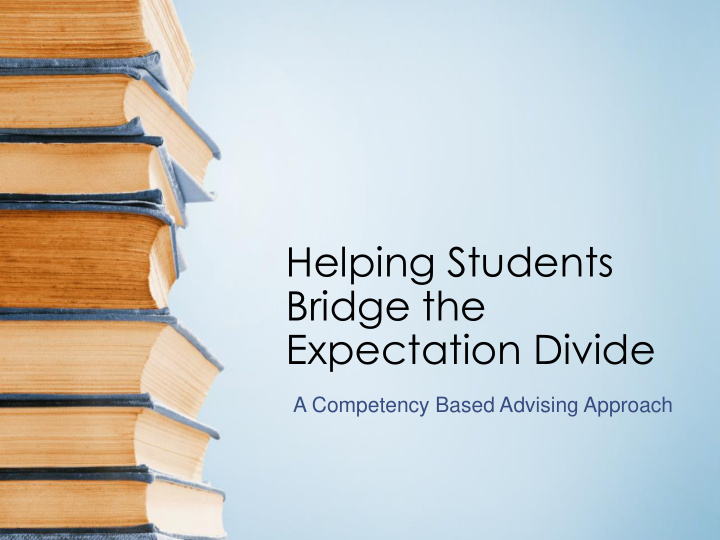



Helping Students Bridge the Expectation Divide A Competency Based Advising Approach
The Expectation Gap 43.4% difference 57.5% difference 54.3% difference http://www.naceweb.org/career-readiness/competencies/employers-rate-career-competencies-new-hire-proficiency/
The Expectation Gap 46.9% 37.8% 24.1% 8.4% 37.5% 5.9% 23.6% 14.2% http://www.naceweb.org/career-readiness/competencies/are-college-graduates-career-ready/
Gaps in Unexpected Places Gaps in MATH are the most severe in occupations where the requirements are low but essential. Gaps in WRITING are found in both low requirement and writing intensive jobs. https://www.burning-glass.com/research-project/baseline-skills/
Why do these gaps exist? • Are students not being taught them? • Are students aware of these expectations? • Are students able to communicate their proficiency?
Identify and Evaluate Values 47% of students seek careers that align with their personal values as opposed to 20-30% aligning with interests. (Duffy & Sedlacek 2007) Cultural/Sociological Differences Differences between groups as well as individuals Much of values-based theoretical approaches derived from European-male perspective; not transferable to other groups *As advisors, we cannot assume our students have the same fundamental values
Example of Evaluating Values Why do you do what you do? How do you want to live your values? What is the result of implementing your values? Who or What do you want to impact? Cucinella, E., Torres, R., & Byrd, H. (2017, October). The Power of Purpose: Coaching Students Towards Self-Efficacy . Presented at the 2017 NACADA National Conference, St. Louis, MO.
Identify & Evaluate Competencies • Started with core competencies for new medical students. • Compared with NACE competencies. • Looked into professional associations and government websites that articulate professional competencies. • Focus on universal competencies with a way to specialize depending on major.
Optimizing Time Take a moment to think about how you spend your advising sessions with students: • How do you allocate time? • What do you spend most of the time doing? • How has time allocation changed from when you started advising? • What could you spend more time doing? • How are we, as advisors, perpetuating increasingly outdated practices as technology makes elements of our roles more efficient?
In short: How do we optimize the time spent with students? AND What might optimize really mean?
Being a Robot vs. Being an Advisor Degree Audit and Planner automates significant portion of advising role How can we adapt as technology improves? Do we exist just to lift holds? https://collegescorecard.ed.gov/
I’m an Advisor, not a …. Redundancy can be an asset For example: Advisors overlap with Retention Office Lack of advising models for talking about post- graduation plans
Existing Theories • Alexander Astin – I-E-O – Five Basic Assumptions – Focus on the importance of involvement • Vivian Carroll McCollum – Developmental & Advising Stages – Tasks for Advisors & Students – Focus on course selection, referral to campus resources
Problems to address: Keeping it universal: • Students need to meet • Non-role specific competency expectations. – Advising roles can change depending on the office, college, • Students need to communicate and institution. experiences in a meaningful • Non-institution specific way. – Size, mission, funding, etc. can • Students need to be ready shape advising role on any given START a job after graduation. campus.
The Myth of Sisyphus • Albert Camus and the Absurd • Do we do things just because it is expected? • How do we help students find meaning in their experiences?
How does Higher Ed do it? Assessment! • Identifies needs • Sets a timetable • Communicates results
Adapted Student Assessment Model (Competency Driven Assessment Model) What drives the student? What does the career expect of them? Targeting experiences Competitiveness
Benchmarking (Finish in 4, Competitive in 3)
Benchmarking • SMART Goals • WOOP – Specific – Wish – Measurable – Outcome – Assignable – Obstacle – Relevant – Plan – Time-based • woopmylife.org
Getting Experiences Hurdles Interventions • Paid vs. Unpaid • Journaling – Apps • Applying late – Google Drive • Active Engagement vs. Passive – Worksheet Observation – An actual journal – Experiential Collateral • Application of Institutional Knowledge – Right office – Right person – Advocating for students
Letters of Recommendation • Does the student know how to ask for one? • Does the writer know how to write one? • What is the timeline for it to be submitted?
Self Reflection • How did a class/semester/experience turn out? – Was it what the student expected? – Did the student like it? – Was the student “successful”? • Review Values and Competencies – Did experience correlate with values? – Can the student link the experience to competencies?
Make Decisions • Is the student on the path to being “competitive”? – If “yes,” what is the next step on the path? – If “no,” is remediation possible and if so, what needs to be done? • Does the student need to seriously consider other options? – Do you have a plan for “Plan B” discussions?
Student vs Employer Perceptions 4.5 4 3.5 3 2.5 2 1.5 1 0.5 0 Interpersonal Intrapersonal Cognitive & Reasoning Content Knowledge Students 3.934342744 3.746475727 3.74029799 3.479222897 Employers 3.6 3.619047619 3.353571429 3.25
Takeaways • Very small “n” – 8 for employers – 44 for students • Employers limited to hiring directors not managers • Perceptions were all still “proficient” • Do more competencies help students better communicate worth? – 8 NACE competencies – 16 competencies on survey
Next Steps • Fine tune employer and student questionnaire • Develop qualitative follow up questions • Develop faculty and staff questionnaire • Develop longitudinal study to gauge changing perceptions over time – Possibly including a Social Judgement Test
Questions? • Resources: goo.gl/2o5YWP • Joe Southerland: southerlandj@umsl.edu • Mike Koertel: koertelmi@umsl.edu • Nancy Childrey: nancy.childrey@slu.edu
Back to the Contact Information • Resources: goo.gl/2o5YWP • Joe Southerland: southerlandj@umsl.edu • Mike Koertel: koertelmi@umsl.edu • Nancy Childrey: nancy.childrey@slu.edu
Recommend
More recommend